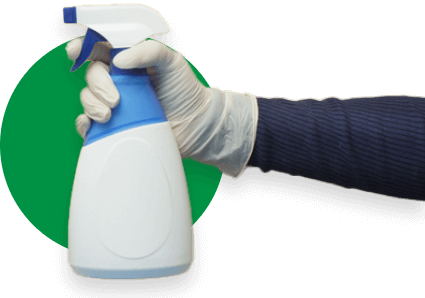Cleaning commercial floors is no small task. Depending on the venue, there is often a lot of area to cover. Not to mention, the floor cleaning process can restrict access to certain areas of your business for a while. There’s also a wide variety of flooring types you might find in a single commercial setting. When you opened your business, floor cleaning was probably not a primary concern. But, floors can quickly become dirty, especially with heavy foot traffic.
If you’re struggling with cleaning commercial floors, don’t worry. This guide offers a step-by-step walkthrough on how to clean commercial floors of many types.
How to Clean Commercial Tile Floors/VCT
Commercial tile floors and VCT (vinyl composition tile) are common in several different commercial settings. Offices, schools, hospitals, hotels, and many retail stores use tile flooring. Commercial tile floors are durable, aesthetically pleasing, and relatively easy to clean compared to other flooring types. However, using the right cleaning method is still important if you want the best results. Here’s what you should know about how to clean commercial vinyl tile floors:
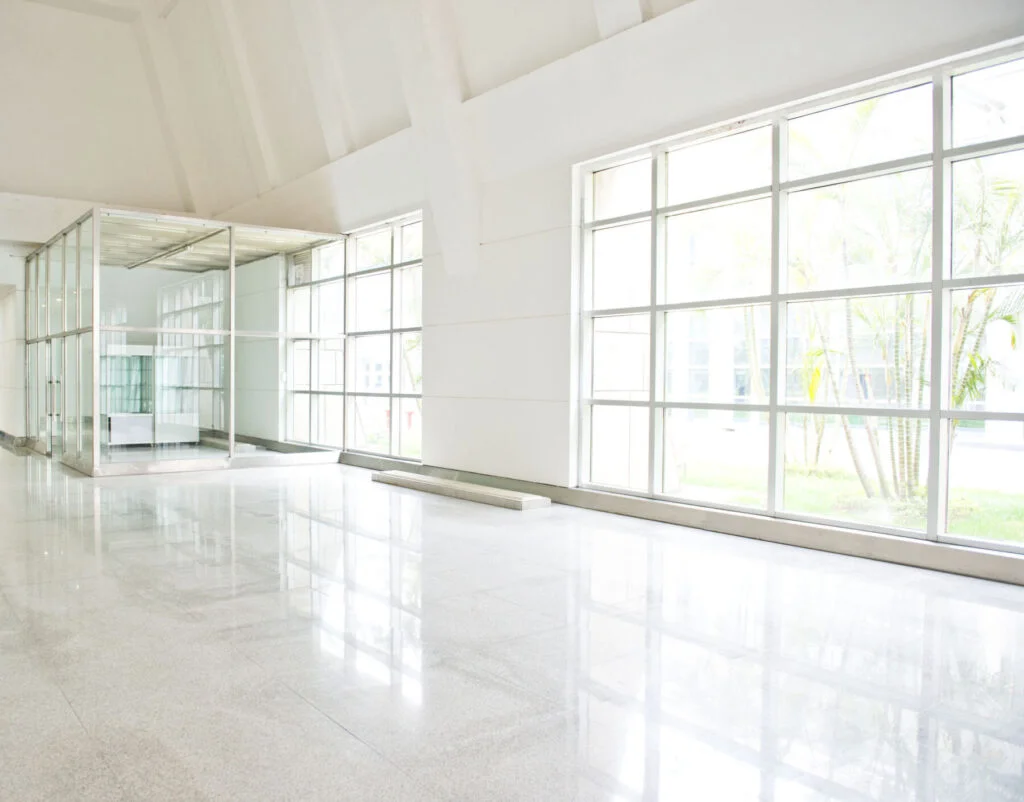
Choose the Right Cleaning Products and Tools
The tools required to clean commercial VCT flooring should be easy to find. Namely, you will need a bucket filled with clean water, a neutral cleaner (pH of 7), and a sponge mop with an automatic scrubber. If you want to dry your floors quickly, you should also use an air mover. Once you have all the supplies, follow these step-by-step instructions on how to clean commercial tile floors:
Step 1. Remove Large Debris
Start by vacuuming or sweeping to remove any large debris. This gets rid of the trash, dust, and some larger spills to make the cleaning easier later on.
Step 2. Make the Cleaning Solution
Fill your bucket with water. For every gallon of water, mix in one ounce of your neutral cleaner. Using a neutral cleaner is crucial for cleaning a commercial tile floor because harsher chemicals can harm the tile. This can leave them looking faded or grimy after cleaning.
Step 3. Scrub the Floor With the Detergent
Once your cleaning solution is properly mixed, it’s time to scrub. Soak your sponge mop in the bucket, and then scrub it across the entire area of the floor. Make sure you don’t neglect corners or underneath counters.
Step 4. Set Up Air Movers
To dry your floors quickly, arrange air movers strategically around the room. Turn the air movers on and let them do their work. The wait before the floors dry will depend on the size of the room.
Step 5. Remove Additional Stains
In most cases, the cleaning process ends at step 4. But, occasionally, you will have tough stains that refuse to disappear easily. To get rid of these stains, you might try increasing the concentration of cleaner in your mop bucket. Or, you can try scrubbing the stains in alternating patterns. With a little elbow grease, you should eventually be able to remove difficult stains from VCT flooring.
How to Clean Commercial Vinyl Floors
Vinyl flooring is another common floor type found in commercial settings. The cleaning process is not too dissimilar from that of cleaning VCT flooring. Vinyl floors may require a few additional care steps compared to vinyl tile flooring, however.
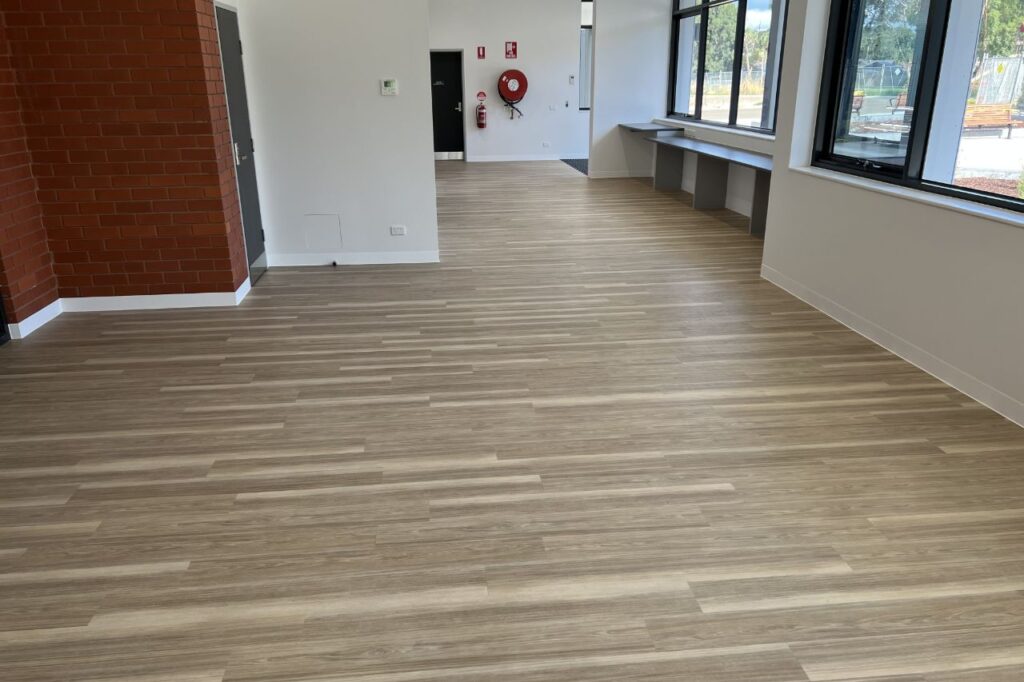
Choose the Right Cleaning Products and Tools
Cleaning vinyl floors requires a mop and mop bucket filled with a neutral floor cleaning detergent. You should also have a soft bristle broom and vacuum cleaner on-hand to remove large debris. You might also use air movers for drying, a power buffing machine, and a floor finish product.
Step 1. Remove Large Debris
Start by sweeping or vacuuming the floor to remove large debris. Dirt, dust, and trash can be removed without the use of floor cleaners.
Step 2. Soak the Mop and Scrub Floors
Lightly soak your mop in the neutral cleaning detergent. Scrub the floors using a figure-eight motion to break up stains and dirt on the floor. Make sure to get the entire area, including corners and under counters.
Step 3. Rinse the Mop with Clean, Hot Water
Once the entire floor is coated in detergent, rinse your mop with hot water. Then scrub over the entire area again with your clean mop to remove detergent.
Step 4. Set Up Air Movers
If you need to quickly remove any lingering dampness, set up your air movers around the room. Turn them on and let them blow the moisture away.
How to Clean Commercial Concrete Floors
Commercial concrete floors are often used in warehouses, as well as in certain parts of hospitals, retail stores, and restaurants. Concrete flooring is highly durable and relatively low maintenance. Concrete floors are among the easiest floor types to clean.
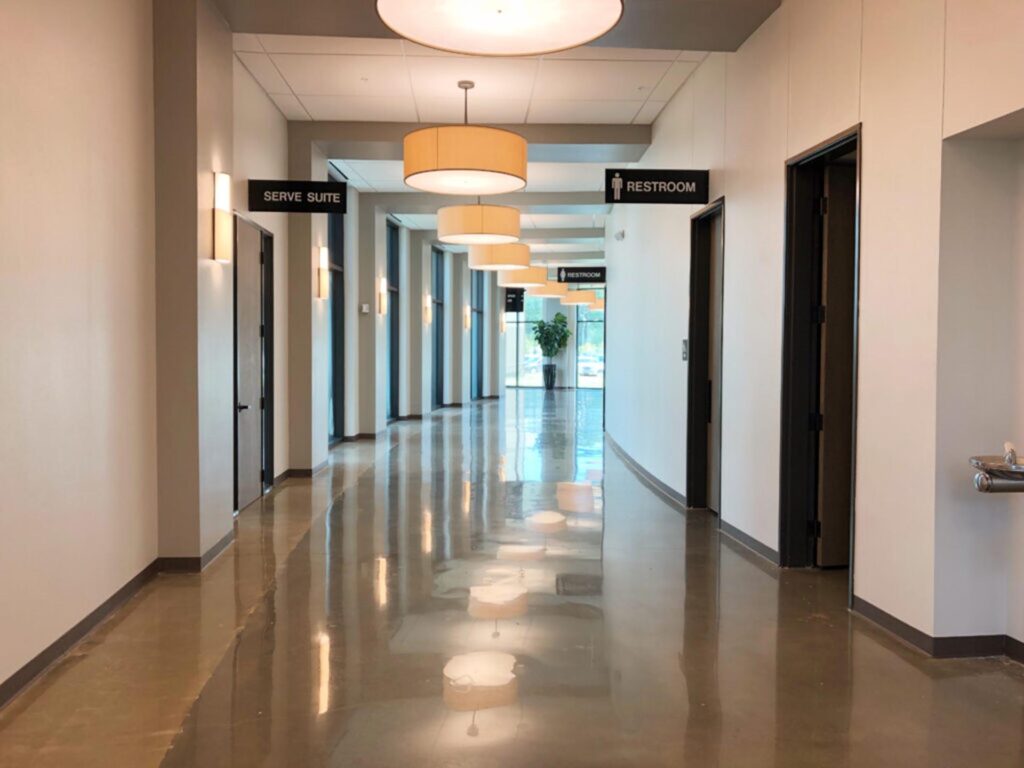
Use the Right Cleaning Products and Tools
Before cleaning a commercial concrete floor, you should gather basic equipment like a broom, a bucket filled with hot water, and a mop. You should use a neutral floor cleaner for concrete floors. Because concrete is very easy to slip on when wet, you should also grab some air movers and wet floor signs. This especially applies if you’re in a high-traffic area.
Step 1. Sweep to Remove Large Debris
If there is any large debris on the floor, start by sweeping it away with your broom.
Step 2. Make the Cleaning Solution
For every gallon of hot water, mix in one ounce of neutral floor cleaner.
Step 3. Wet Mop With Cleaning Solution
Once your solution is ready, soak the floor with it using your mop. Let the floor soak for a minute afterward so that the cleaner has time to break up dirt and stains.
Step 4. Rinse Your Mop with Clean Water and Scrub Again
Once your floor cleaner has had time to soak, mop it up. Rinse your mop with clean water then dry mop the wet floor to remove the cleaning solution. Concrete is a porous surface, so leaving the cleaning solution on it for too long can cause it to absorb moisture.
Step 5. Set Up Air Movers
Concrete commercial floors are very slick when wet, even if just slightly damp. Set up air movers to remove any leftover moisture as quickly as possible. Also set up wet floor signs if you’re in an area with heavy foot traffic.
How to Clean Commercial Carpet Floors
Commercial carpet floors are common in hotels, stores, offices, churches, and many other settings. Additionally, commercial carpet floors are typically soft, vibrant, and have a beautiful appearance. However, carpeted surfaces are often some of the most difficult commercial floors to clean. You must wait for carpeted surfaces to dry.

Choose the Right Cleaning Products and Tools
While cleaning commercial carpet flooring can be challenging, it does not require many tools. You will need a vacuum, a carpet cleaner and cleaning solution, and air movers or carpet-drying fans before getting started.
Step 1. Vacuum to Remove Large Debris
Start by vacuuming to remove any large debris that doesn’t require a carpet cleaning solution for removal. You should vacuum commercial carpet floors regularly (preferably daily) to require less frequent deep cleaning.
Step 2. Spray Area with Carpet Cleaning Solution
Once you have vacuumed, spray the entire carpeted area with carpet cleaning solution. Some carpet cleaning machines will soak the carpet as they work. But in other cases, you need to soak the carpet manually.
Step 3: Go Over the Area with Carpet Cleaner
There are several different commercial carpet cleaning methods. However, in all of them, you need to go over or soak the entire area with a commercial carpet cleaner. Remember that carpet cleaners are not vacuum cleaners. You need to work at a slower pace with most carpet cleaners to soak everything and loosen dirt, dust, and allergens.
Step 4: Set Up Carpet-Dryers
Carpet tends to soak up moisture, so you should set up carpet-drying fans all over the area after cleaning. Otherwise, it might take longer for your carpets to dry.
How to Clean Commercial Linoleum Floors
Linoleum commercial flooring is popular because it’s cost-effective, versatile, and extremely durable. However, without proper care, linoleum floors can become easily discolored or scratched over time. To protect your commercial linoleum floors, follow these basic care steps.
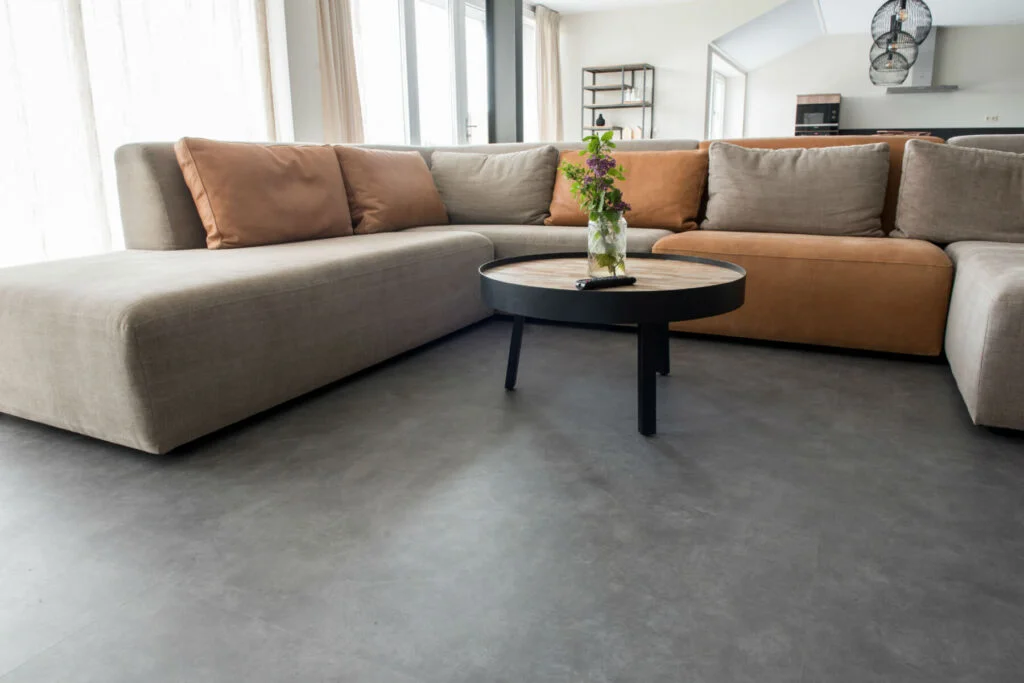
Use the Right Cleaning Products and Tools
You will need several products and tools when cleaning linoleum floors, but all are easy to find. You should have a vacuum cleaner or broom, a soft-bristle brush, a microfiber mop, a bucket with hot water, baking soda, vinegar, and mild dish soap. If you want, you can also use old towels for drying the floor later on.
Step 1. Remove Large Debris
Vacuum cleaners and brooms can be used on linoleum floors to remove large debris before the deep cleaning.
Step 2. Make Cleaning Solution
Harsh chemicals can discolor linoleum flooring. Because of this, it’s best to use natural, household cleaning products on commercial linoleum floors. For every gallon of hot water, mix in one cup of vinegar and a few drops of mild dish soap.
Step 3. Soak Floor With Microfiber Mop
Use a microfiber mop to avoid scratching your linoleum floor. Gently soak the floor with your cleaning solution until the entire area is covered.
Step 4. Scrub with Soft-Bristle Brush
Once the area is soaked, scrub it gently with your soft-bristle brush to remove tough stains.
Step 5. Mop Again with Clean Mop
Once the area has been scrubbed, use clean water to rinse off your mop. Run the mop over again to remove the cleaning solution and most of the moisture.
Step 6. Dry Floor
Linoleum floors can be pretty slick when wet, so you’ll want to try it fairly quickly. You can use old towels if the area is not too large. If the area is large, you can set up air movers around the room to dry it more efficiently.
How to Clean Commercial Hardwood Floors
Commercial hardwood floors look great and are durable when treated well. With proper maintenance, hardwood flooring can last multiple generations. But hardwood flooring requires special care to prolong its life and luster.
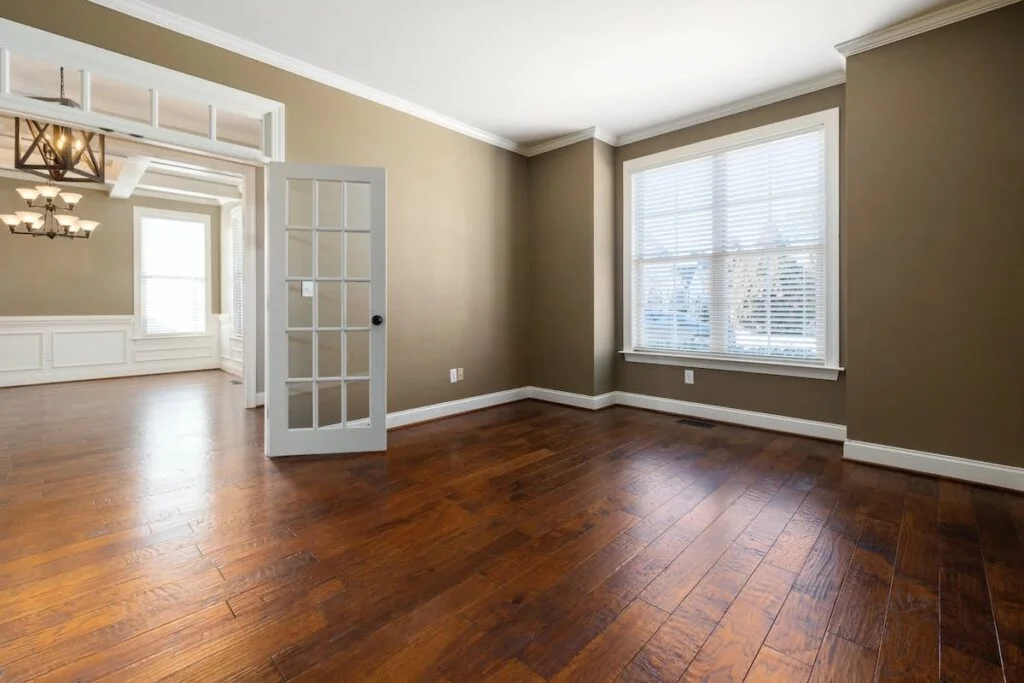
Use the Right Cleaning Products and Tools
When cleaning commercial hardwood floors, you’ll first need a broom or vacuum. Other necessary materials include a mop and bucket, liquid floor cleaner, and air movers.
Step 1. Remove Large Debris
Start by sweeping or vacuuming your hardwood floors to remove any dust and dirt on the surface.
Step 2. Dampen Floor With Liquid Cleaning Solution
Consult your hardwood flooring manufacturer’s recommendation to choose the right cleaning product as each type of hardwood flooring is unique. When mopping a hardwood floor, be sure to wring out the mop first. Hardwood is porous, so you don’t want to soak it too heavily. A light coating of cleaner will do the trick.
Step 3. Rinse Mop and Scrub Again
Once the whole area is coated, rinse your mop with clean water and scrub again to remove the cleaner. Let the cleaner soak for a minute to break up stains.
Step 4: Dry Floors
As mentioned, hardwood floors will soak up moisture if you let them sit. So you should set up air movers or use towels to quickly dry off your hardwood flooring after cleaning.
FAQs About Commercial Floor Cleaning
How do you keep commercial floors clean?
You can keep commercial floors clean by performing routine cleaning by sweeping or vacuuming regularly. For deep cleaning, you can hire the services of a commercial floor cleaner.
What should you not clean tile floors with?
You should not use acidic cleaners on tile floors, as they can cause discoloration.
How often should commercial floors be waxed?
Commercial flooring that requires wax should be waxed once or twice annually.
What is the process of cleaning marble floors in a commercial building?
Marble floors should be cleaned using a solution of hot water and mild dish soap.
How to choose the best commercial floor cleaning companies?
To find the best commercial floor cleaning companies in your area, read online customer reviews and look up company certifications and services. Read about Dallas Janitorial’s cleaning services to learn more.
Commercial Floor Cleaning Expertise for All Flooring Types
Want help cleaning your commercial floors? Dallas Janitorial Services is staffed by expert professionals who know what it takes to clean every flooring type. Not only that, but we offer a 100% customer satisfaction guarantee. Contact us to learn more and get a free quote. Or continue reading to learn more about the cost and benefits of janitorial services.







